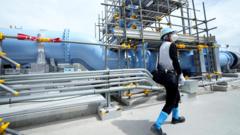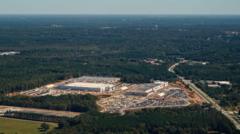In a significant policy change, Japan will ramp up its reliance on nuclear power as it aims to satisfy the growing energy demands of sectors such as artificial intelligence and semiconductor manufacturing. The energy strategy approved by the government on Tuesday advocates for the "maximisation of nuclear energy usage" and removes previous commitments to decreasing dependence on this energy source. As part of the plan set forth by the Ministry of Economy, Trade and Industry, Japan aims for nuclear power to contribute 20% to its grid supply by 2040, which contrasts sharply with the current 8.5% share in 2023. This decision comes more than a decade after the catastrophic Fukushima nuclear disaster in 2011, which resulted in the death of over 18,000 individuals and considerably altered the nation’s energy landscape.
Japanese Government Shifts Energy Policy to Increase Nuclear Reliance

Japanese Government Shifts Energy Policy to Increase Nuclear Reliance
Japan embarks on a controversial energy strategy to boost nuclear power despite Fukushima's shadow.
Japan currently operates only 14 commercial nuclear reactors, a steep decline from the 54 operational prior to the disaster when nuclear energy accounted for 30% of the nation's energy. The new energy strategy requires parliamentary approval, where it will be debated in the coming weeks. Lawmakers like Daishiro Yamagiwa emphasize the necessity of nuclear energy to reduce carbon emissions and secure a domestic energy supply, especially in light of international conflicts affecting fossil fuel access.
However, experts express concern over the potential risks and economic implications of increasing nuclear energy dependency. Japan must import uranium to fuel its reactors, raising its reliance on foreign sources. The risk of accidents remains a critical issue, exacerbated by Japan's seismic activity, as highlighted by the recent earthquake that affected a potential nuclear site in the Noto peninsula.
Amid these developments, the public memory of Fukushima looms large. Many citizens, including mothers like Yuko Maruyama, voice strong opposition to the government’s renewed focus on nuclear energy, citing safety and children's welfare as major concerns. The Fukushima disaster remains a potent symbol of nuclear risk, prompting environmental organizations like Greenpeace to condemn Japan's approach as "outrageous" given the persistent risks associated with nuclear energy and the long-term management of radioactive waste.
Experts predict that to achieve the government’s goal, 33 reactors need to be restarted, but the slow pace of safety inspections and local resistance complicates this objective. Furthermore, many existing plants are outdated and will require upgrades to meet modern safety standards. As regulatory bodies gradually approve the continued operation of older reactors, Japan faces a challenging path toward fulfilling its ambitious nuclear energy targets while addressing public anxiety over past nuclear failures.
However, experts express concern over the potential risks and economic implications of increasing nuclear energy dependency. Japan must import uranium to fuel its reactors, raising its reliance on foreign sources. The risk of accidents remains a critical issue, exacerbated by Japan's seismic activity, as highlighted by the recent earthquake that affected a potential nuclear site in the Noto peninsula.
Amid these developments, the public memory of Fukushima looms large. Many citizens, including mothers like Yuko Maruyama, voice strong opposition to the government’s renewed focus on nuclear energy, citing safety and children's welfare as major concerns. The Fukushima disaster remains a potent symbol of nuclear risk, prompting environmental organizations like Greenpeace to condemn Japan's approach as "outrageous" given the persistent risks associated with nuclear energy and the long-term management of radioactive waste.
Experts predict that to achieve the government’s goal, 33 reactors need to be restarted, but the slow pace of safety inspections and local resistance complicates this objective. Furthermore, many existing plants are outdated and will require upgrades to meet modern safety standards. As regulatory bodies gradually approve the continued operation of older reactors, Japan faces a challenging path toward fulfilling its ambitious nuclear energy targets while addressing public anxiety over past nuclear failures.




















